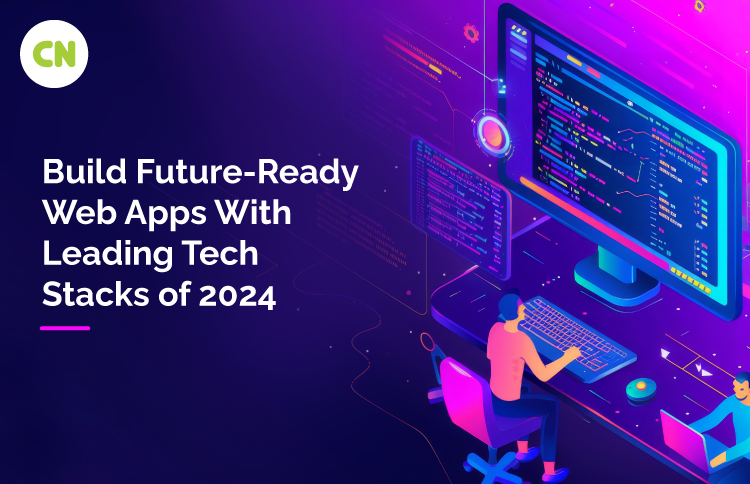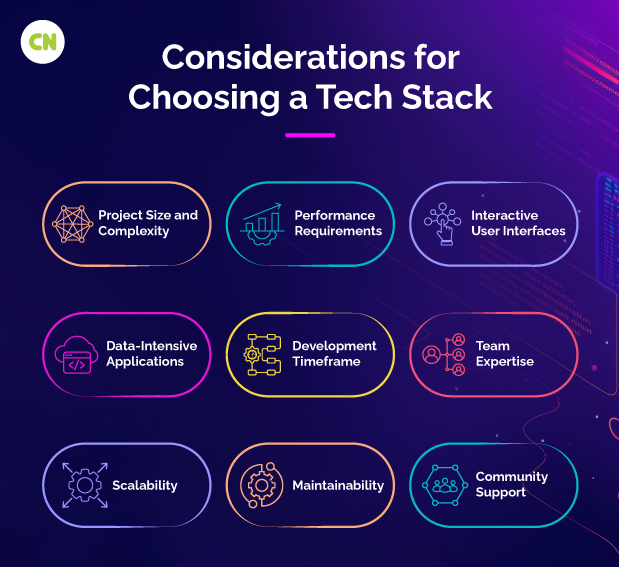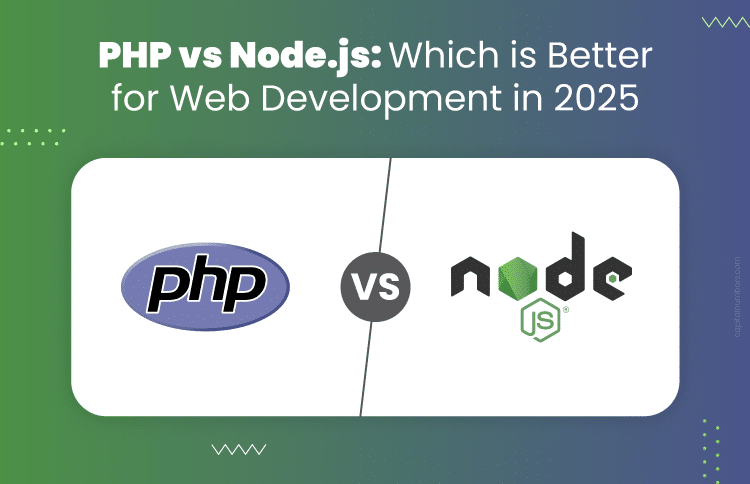Build Future-Ready Web Apps With Leading Tech Stacks of 2024
Table of Contents
In today’s digital world, choosing the right tech stack is essential for web application development. This decision affects both the start and the future growth of a project. By picking the best tech stacks of 2024, developers and companies make sure their web apps are up-to-date with technology. This keeps them competitive, efficient, and ready for new challenges. So, knowing and selecting the right tech stack is key to creating web apps that are future-proof.
Web Application Development Trends 2024
Web application development has evolved through continuous innovation. We’ve progressed from simple HTML pages to complex applications, offering rich user experiences like desktop software. Key milestones include:
- The rise of JavaScript frameworks, which have revolutionized how developers build interactive web applications.
- The adoption of responsive web design, ensuring web applications work seamlessly across various devices and screen sizes.
- Serverless architectures are becoming popular, cutting down on traditional server management and making apps more scalable.
- The shift towards API-first development, making it easier to integrate with other services and platforms.
- The use of containerization and microservices, improving deployment processes and application scalability.
- The advancement in browser capabilities (Wasm, WebRTC, WebGL, etc.), supporting more complex functionalities directly within the web browser.
In 2024, these technologies are converging, integrating AI and machine learning to produce more intelligent, responsive, personalized web applications.
Definition and Components of a Tech Stack
A tech stack is the combination of programming languages, frameworks, databases, front-end tools, back-end tools, and applications connected via APIs that are used to build a software project. In web development, this typically includes two main components: the front end, or client-side, and the back end, or server-side.
- Front-end technologies include HTML, CSS, and JavaScript, alongside frameworks and libraries like React, Angular, or Vue.js, which enhance user interface development.
- Back-end technologies comprise programming languages such as Python, Ruby, PHP, or JavaScript (Node.js), and frameworks like Django, Ruby on Rails, or Express that facilitate server-side development. Databases such as PostgreSQL, MongoDB, or MySQL store, retrieve, and manage data.
Full-stack Development: What It Means for Web Developers in 2024
Full-stack development involves building both the front-end and back-end of an application. It’s about understanding the entire development process, from deployment to maintenance and improvement. Full-stack developers are proficient in various technologies and can make informed decisions for both aspects of the app. This leads to more efficient development and a cohesive user experience.
- Integration Skills: Developers need to proficiently integrate frontend and backend systems via RESTful APIs or GraphQL, ensuring smooth data flow and interaction between the client-side and server-side.
- Understanding of MVC and MVVM Patterns: Knowledge of architectural patterns like Model-View-Controller (MVC) and Model-View-ViewModel (MVVM) assists in structuring applications for clarity, scalability, and maintainability.
- Holistic Approach to Development: Full-stack developers must approach projects with a comprehensive perspective, considering both the user experience and the application’s performance and scalability. This involves making informed decisions on when to offload tasks to the client-side or handle them on the server-side for optimal efficiency.
Analysis of Leading Tech Stacks for Web Development and Their Features
In 2024, several tech stacks lead the way in web development, each with unique features:
- MERN (MongoDB, Express, React, Node.js): MERN stack is highly valued for its complete JavaScript development capabilities, enabling the creation of fast and scalable web applications. It’s especially useful for building single-page applications (SPAs).
- MEAN (MongoDB, Express, Angular, Node.js): Similar to MERN but utilizes Angular for front-end development, offering robust solutions for dynamic web apps with a focus on productivity and maintainability.
- Django + React/Vue.js: Combining Django’s powerful backend framework with React or Vue.js for the frontend helps create scalable, secure apps with rich user interfaces. This is especially beneficial for applications that demand complex database operations.
- Ruby on Rails + React: This stack uses Rails’ convention over the configuration principle for quick application development and React’s component-based architecture for dynamic user interfaces. It’s ideal for startups looking to rapidly prototype and deploy web applications.
How Tech Stacks Cater to Different Project Needs in Web App Development
The choice of a tech stack often hinges on specific project requirements:
- Scalability: For applications expected to grow quickly in user base and functionality, stacks like MERN or MEAN offer scalability and flexibility.
- Security: Projects with stringent security requirements may benefit from Django’s secure defaults.
- Rapid Development: Ruby on Rails + React can significantly speed up development time, making it ideal for startups.
- Complex Data Management: Applications requiring intricate data handling could leverage Django’s ORM for efficient database management.
Factors to Consider When Selecting a Tech Stack
- Project Size and Complexity: Small projects might benefit from simpler stacks like LAMP (Linux, Apache, MySQL, PHP), while large-scale applications might require more comprehensive solutions like the MEAN (MongoDB, Express.js, Angular, Node.js) or MERN (MongoDB, Express.js, React, Node.js) stacks.
- Performance Requirements: High-performance applications, such as gaming platforms or financial trading systems, might prioritize tech stacks that can handle real-time data processing efficiently, such as those incorporating Node.js for its non-blocking I/O operations.
- Interactive User Interfaces: For projects requiring highly interactive and dynamic user interfaces, such as SPAs or mobile applications, frameworks like React or Vue.js, part of the MERN or MEVN stacks, offer robust solutions.
- Data-Intensive Applications: Projects that involve handling large volumes of data or complex database operations might lean towards tech stacks that include robust databases and ORM tools, such as Django with PostgreSQL, facilitating efficient data management and queries.
- Development Timeframe: Projects with tight deadlines may benefit from frameworks that offer rapid development features, such as Ruby on Rails or Django, known for their “convention over configuration” principle and rich set of libraries.
- Team Expertise: The existing skills of the development team play a crucial role. Choosing a tech stack that the team is already familiar with can significantly reduce the learning curve and accelerate the development process.
- Scalability: It’s crucial to choose a tech stack that not only meets current needs but can also scale as the project grows. Microservices architectures, for example, allow for the scaling of individual components of the application independently, accommodating growth without significant restructuring.
- Maintainability: The chosen tech stack should support clean, readable code and modular architecture to facilitate future updates and maintenance. Frameworks that enforce MVC (Model-View-Controller) patterns, such as Laravel or Ruby on Rails, contribute to maintainable codebases.
- Community Support: A strong community provides access to a wealth of resources, including documentation, tools, libraries, and forums for troubleshooting. Popular technologies like Python, JavaScript, and their associated frameworks tend to have vibrant communities, ensuring long-term support and resources for developers.
Essential Tools and Technologies for Modern Web Developers
- Version Control Systems: Tools like Git are indispensable for modern development workflows, enabling collaboration, version tracking, and code management.
- Code Editors and IDEs: Visual Studio Code, JetBrains WebStorm, and Sublime Text offer powerful coding environments that are extensible and support a wide array of programming languages and frameworks.
- Database Management: Proficiency in both SQL (e.g., PostgreSQL, MySQL) and NoSQL (e.g., MongoDB, Cassandra) databases is essential, along with understanding ORM (Object-Relational Mapping) tools for database interactions.
- Cloud Services: Familiarity with AWS, Azure, or Google Cloud Platform is necessary for deploying and managing web applications, along with serverless computing and containerization technologies like Docker and Kubernetes for scalable, efficient application deployment.
- DevOps Tools: Understanding continuous integration and continuous deployment (CI/CD) pipelines, using tools like Jenkins, GitLab CI, or GitHub Actions, helps in automating the testing and deployment processes.
Future Trends in Tech Stack for Web Development
The landscape of web development is continually evolving, driven by advancements in technology and shifts in user expectations. As we look beyond 2024, several emerging technologies are set to redefine the composition and capabilities of tech stacks in web development. Understanding these trends and preparing for their impact is crucial for developers and companies aiming to stay at the forefront of the industry.
- Artificial Intelligence and Machine Learning: AI and ML integration into web development processes and applications is expected to grow. From automated code generation and optimization to personalized user experiences based on behavior analysis, AI could significantly enhance efficiency and user engagement.
- Internet of Things (IoT): As IoT devices become more prevalent, web applications will increasingly need to integrate and communicate with a wide array of devices. This requires tech stacks that support real-time data processing, analysis, and secure device connectivity.
- Blockchain Technology: Blockchain’s applications in web development are expanding beyond cryptocurrencies. Decentralized applications (DApps) for secure transactions, data storage, and identity verification are necessitating the inclusion of blockchain technologies in web development tech stacks.
- Modular Architecture: The shift towards modular and microservices architectures is expected to continue, enabling more scalable and flexible web applications. This will require tech stacks that facilitate easy integration and management of disparate services and components.
- Increased Emphasis on Security and Privacy: With growing concerns over data privacy and security, tech stacks will evolve to include advanced security features and encryption protocols by default, making web applications more resilient to cyber threats.
Conclusion
Now is the perfect time to reevaluate your current tech stack. Is it positioned to meet the challenges of tomorrow? Consider reaching out to professional web developers or consulting with web development companies to explore how updating your tech stack can drive your projects forward.
















